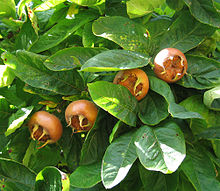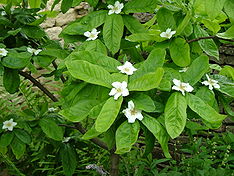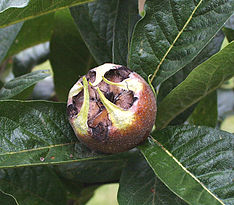- Mespilus
-
This article is about the genus of flowering plants called Medlar. For other uses, see Medlar.
Mespilus 
Common Medlar foliage and fruit Scientific classification Kingdom: Plantae (unranked): Angiosperms (unranked): Eudicots (unranked): Rosids Order: Rosales Family: Rosaceae Subfamily: Amygdaloideae Tribe: Maleae Subtribe: Malinae Genus: Mespilus
Bosc ex SpachSpecies Mespilus, commonly called Medlar, is a genus of two species of flowering plants in the subfamily Maloideae of the family Rosaceae. One, Mespilus germanica, is a long-known native of southwest Asia and possibly also southeastern Europe (Black Sea coast of modern Turkey), and the other, Mespilus canescens, was discovered in North America in 1990.
Mespilus germanica features an unusual apple-like fruit that requires bletting to eat; although not widely eaten today, consumption of these fruits was much more common in the past.
Contents
Plant
Mespilus are deciduous large shrubs to small trees growing up to 8 metres (26 ft) tall. The leaves are dark green and elliptic, 6–15 centimetres (2.4–5.9 in) long and 3–4 centimetres (1.2–1.6 in) wide. The leaves turn red in autumn before falling. The five-petaled white flowers, produced in late spring, are hermaphrodite and pollinated by bees. The fruit is a pome, 2–3 centimetres (0.79–1.2 in) in diameter, with wide-spreading persistent sepals giving a "hollow" appearance to the fruit; it is matte brown in M. germanica and glossy red in M. canescens.
History
Mespilus germanica can most commonly be found today in Southwest Asia and Southeastern Europe, i.e. along the Black Sea coast of modern Turkey. The fruit is native to Asia Minor [1], as well as the Caucasus and Northern Iran, and has an ancient history of cultivation; it was grown by the ancient Greeks and Romans, beginning in the 2nd century BCE. Mespilus germanica was a very popular fruit in Western Europe during the Victorian era;[citation needed] but has fallen out of favour there.
Related plants
Within subfamily Spiraeoideae, Mespilus is most closely related to Crataegus, Amelanchier, Peraphyllum, and Malacomeles.[2]
The genus Eriobotrya (loquats) was once considered to be closely related to Mespilus, and is still sometimes called the "Japanese Medlar".
Many authors group Mespilus together with Crataegus in a single genus, with species names Crataegus germanica (L.) Kuntze, and Crataegus ×canescens (J. B. Phipps) T. A. Dickinson & E. Y. Y. Lo.[3][4][5][6][7][8]
Availability
Medlars are not widely available at present, though one can purchase the fruit and trees of Mespilus germanica from specialists.
Trees
The trees are self-fertilizing and long-lived (they can be hundreds of years old), and saplings are cheaply available by mail order in the UK.
External links
- Medlars On Bough photograph
- Medlar Fruit & Jelly, photographs and discussions of medlar preparation
- Medlar Jelly at Tiptree, photo of medlar jelly at vendor in the United Kingdom
- Medlars at Raintree, photo and description at vendor of medlar seedlings in the United States
- Medlar Cheese, a recipe for medlar cheese at historicfood.com
- One Green World a provider of medlar trees in Oregon
Notes
- ^ http://www.nytimes.com/2004/11/03/dining/03MEDL.html
- ^ Campbell, C.S.; Evans, R.C.; Morgan, D.R.; Dickinson, T.A.; Arsenault, M.P. (2007). Phylogeny of subtribe Pyrinae (formerly the Maloideae, Rosaceae): Limited resolution of a complex evolutionary history. Plant Systematics and Evolution. 266(1–2): 119–145.
- ^ Scopoli, G.A. 1760. Flora Carniolica Exhibens Plantas Carniolae Indigenas et Distributas in Classes Naturales cum Differentiis Specificis, Synonymis Recentiorum, Locis Natalibus, Nominibus Incolarum, Observationibus Selectis, Viribus Medicis..
- ^ Castiglioni, L.G. 1790. Luigi Castiglioni's Viaggio travels in the United States of North America 1785-1787 with natural history commentary and Luigi Castiglioni's Botanical Observations: Viaggio negli Stati Uniti dell' America Settentrionalle fatto negli Anni 1785, 1786 e 1787....
- ^ Moench, C. 1794. Methodus Plantas Horti Botanici et Agri Marburgensis: Reprint with introduction and biography by William T. Stearn. Otto Koeltz Antiquariat, Koenigstein-Taunus.
- ^ Koch, K. 1869. Dendrologie: Bäume, Sträucher und Halbsträucher, welche in Mittel- un Nord- Europa in Freien kultivirt werden. Verlag von Ferdinand Enke, Erlangen.
- ^ Kuntze, O. 1891. Revisio generum plantarum. A. Felix, Leipzig.
- ^ Lo, E.; Stefanović, S.; Dickinson, T.A. (2007). Molecular reapprasial of relationships between Crataegus and Mespilus (Rosaceae, Pyreae) – Two genera or one? Systematic Botany. 32(3): 596–616.
Wikimedia Foundation. 2010.


